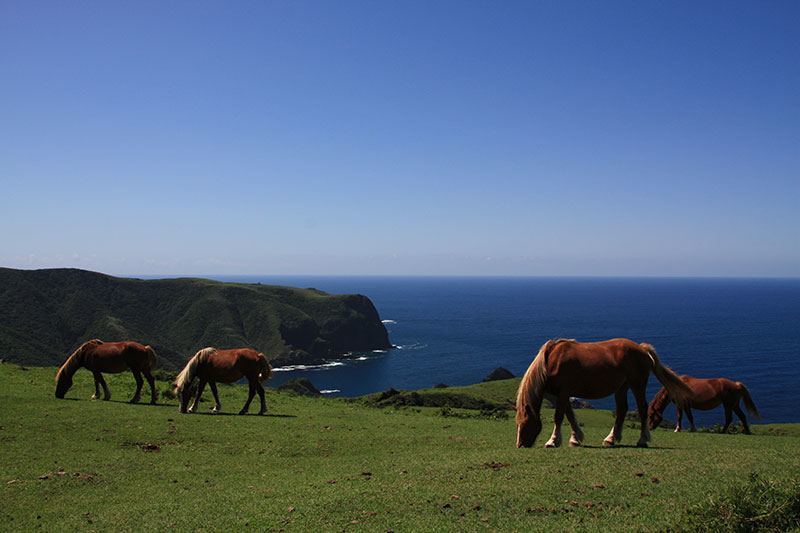Like this post? Help us by sharing it!
Situated in the Sea of Japan, to the north of Shimane Prefecture (south-west of mainland Honshu), the Oki Islands have a natural and cultural landscape unlike anywhere else. If you are looking for a truly unique Japanese adventure, look no further than the remote Oki Islands.
By considering the geohistory of the area, we can begin to understand the sui generis nature of its landscapes and cultural traditions. Developed through a series of stages, the land from which the Oki Islands consists was once part of the Eurasian Continent. Over time it sank first to the bottom of a lake, then to the bottom of a deep sea. Large-scale volcanic activity saw eruptions thrust the land up from upon deep and the islands were brought into existence. They became connected to mainland Japan during the glacial ages, before separating once more and taking their current form. In September of 2013, the Oki Islands were granted Global Geopark status. Geoparks are “designated areas of significant geographical heritage”, an initiative supported by UNESCO.
The relatively recent history of Oki is interesting, too. Its geographical location resulted in Oki being an important port of call for traders sailing around Japan, and for those en route to mainland Asia, since ancient times. Obsidian (a type of naturally occurring volcanic glass) is believed to have been an Oki export for as long as 30,000 years.
Due to its remoteness, the Oki Islands were a place of exile for court nobles for around 900 years. These nobles introduced court culture and traditions that failed to reach less secluded places on the mainland. The most famous and celebrated exile was the Emperor Go-Toba. Following his defeat in the Jōkyu Rebellion, he was sent to the islands in 1221 to see out his days. In 1331, following the Gēnko Incident. Emperor Go-Daigo was also exiled to the Oki Province, as it was known at the time. However, with some assistance from powerful friends, he escaped to the neighbouring Tottori Prefecture on the mainland. Here, at Funigama Mountain (present day Senjo-san), he built an army, returned to Kyoto and re-took the throne from Emperor Kōgon.
The beautiful and interesting features of the Oki Islands are many and varied, and thus selecting just a few to describe is a difficult task. However, listed below are 5 sites and traditions of particular interest.
Dogō Island
1) Ushitsuki
Ushitsuki (Bull Sumo), is one of the oldest cultural practices in Japan, with a history of more than 800 years. It has been practiced on Oki since the time of Emperor Go-Toba and can still to this day be observed on Dogō Island. As with regular sumo, much of the spectacle is concerned with Shinto rituals and traditions. The island is split into bull sumo fighting sides that contest for honour, not financial gain. The well-cared-for bulls lock horns and push against other until one of them turns away. The bulls are then separated by their handlers and one of them pronounced the victor.
2) Chichi-sugi
There are many majestic Japanese cedar trees on Dogo Island. The Oki Islands are where the Ura-sugi type last originated, as the species was able to survive in Oki during the last glacial age. One famous example on Dogo is the Chichi-sugi, which means “Breast cedar” due to its unusual shape. The tree itself is a shrine dedicated to a maternal deity and is about 800 years old.
3) Shirashima Coast Lookout
Stunning coastal views can be enjoyed from this popular viewpoint. The white cliffs here contrast wonderfully against the clear blue sea and deep green of the pine trees carpeting the coastline. Shirashima is a good spot to observe Streaked shearwater birds and hydrangeas, which bloom until November.
Nishinoshima Island
4) Mt. Takuhiki
At 452 metres, Mt. Takuhiki is the tallest mountain on the island and is the central pyroclastic cone of the Dōzen Caldera. From the parking area, take a pleasant 15 minute hike through the forest to the mysterious Takuhi Shrine, the oldest structure of its type in the Oki Islands and designated as an Important Cultural Property of Japan. Built partially into a cave, the shrine is dedicated to the deity of safe sea voyages and has attracted sailors and fishermen praying for maritime safety for hundreds of years.
5) Kuniga Coast
The Kuniga Coast is arguably the most photogenic spot on the Oki Islands and is not to be missed. A 2.3km walking trail winds its way down from a height of 257 metres, past various interesting rock structures formed as a result of volcanic activity and subsequent coastal erosion, all the while offering spectacular coastal views. The trail, considered one of the Top 100 Walking Trails in Japan, takes you past a natural rock arch known as the Tsūtenkyō (Bridge to Heaven) and a grouping of oddly shaped rocks called Tenjyō-kai (Heavenly World). Horses and cows share the route with the walkers, adding an extra element to an already photogenic setting. The whole, breathtaking scene can be viewed from the Akao Lookout.
* The Oki Islands can be reached by ferry in approximately 2½ hours from Sakaiminato (Tottori) and Shichirui (Shimane) Ports. The Rural Japan Explorer Tour runs for the first time this May and is completely sold out. Don’t miss out on this beautiful place at this beautiful time of year for 2016 with a tour set for 16th May.









